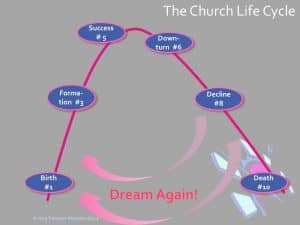A Brief Explanation of the Church Life-Cycle
 Birth (1) – Being a part of this brand-new church is one of the most exciting things I’ve ever been in on. Everyone is helping; spirits are high; everybody is having fun! Many are inviting new people to come for we have nowhere to go except up! We don’t have much to offer as a church, but it sure is exhilarating!
Birth (1) – Being a part of this brand-new church is one of the most exciting things I’ve ever been in on. Everyone is helping; spirits are high; everybody is having fun! Many are inviting new people to come for we have nowhere to go except up! We don’t have much to offer as a church, but it sure is exhilarating!
Formation (3) – Our church is not quite as exciting as when it was brand new, but it’s still pretty neat. A very high percentage of those who attend are doing something to help – even if it’s just moving chairs around – and most of us are inviting new folks. We’re now fixing up a building and we’re beginning to get some ministries, besides the single worship service we started with.
Success (5) – Our church has now reached a peak. It is truly firing on all cylinders. Lost people are being won to Christ; believers are growing in their faith; growing believers are being equipped for ministry; some are even being sent to the mission fields of the world or involved in church planting efforts in our own area. It’s not quite as exciting as it was at #1 or #3, but we’re more mature than we were then and we’re more effective for Christ than ever. At this point, we don’t want to change anything. Some of us are working at making sure we can keep doing our wonderful ministries in exactly the same way for many years to come.
Downturn (6) – Our church reached its peak two years ago. It’s still a pretty good church but it’s not quite what it was back at #5. Externally, not much has changed. Internally, however, folks are wanting to keep doing ministries the way we were doing them two years ago, even though they’re not working as well. A lower percentage of our folks are serving and bringing guests. People are beginning to get quite protective of our nice building. I don’t think people are praying as much as they were two years ago and we certainly aren’t as “on fire” as we once were. Our church is satisfied with its growth so we are not so focused on those outside our doors anymore. After all, “one in the hand is worth two in the bush.”
Decline (8) – Our church is unmistakably on a downhill slide. We’re still doing the same ministries even though most of them are not very effective. Our leaders have gone from making faith-based, forward-looking decisions, to cautious, fear-based, backward-looking decisions. We’ve gone from “who can we win?” to “whom can we keep?” Too many of our personal relationships have gone sour, and no one seems to care about that. Sayings like “we’ve never done it that way” and “we tried that once and it didn’t work” are now heard frequently in our hallways. We are inward focused; everything is for “us four and no more.” For some reason our attendance is down, our giving is down and our winning of the lost is down. People are leaving because other people are leaving; I guess no one wants to get stuck paying the mortgage and turning off the lights.
Death (10) – Our church is now on the verge of disbanding. We just had a huge blow-up, a conflagration, and I’m not sure why it happened. It almost seems as if a number of “brush fires” came together and formed a real firestorm. We haven’t seen anybody trust Christ in years. We might be best off “throwing in the towel.”
So what’s a congregation to do? Are we locked into the church life-cycle?
Revitalization – I used the think that it was at #6 (above) where a church leadership team needed to start praying about revitalization. I was wrong. It is when a church is at its peak (#5) that church leaders need to start dreaming new dreams. History shows us that we can’t keep doing the same ministries year after year with the same results because the world around us is changing continually. Church consultants (like me) can help you with church revitalization.
Restoration – Some writers use this term as a synonym for revitalization. Personally, I don’t like it or use it. Here’s why: Restoration implies that a congregation can turn back the clock, recreating a church as it once existed, like restoring a piece of furniture or an old car. This however, is not possible. Churches are dynamic, constantly changing organizations in a dynamic, constantly changing world. While we can return to our former joy and passion, trying to recreate a church from an earlier decade does not and cannot succeed. Maybe you’ve heard it said: “If 1955 ever returns, our church will be ready.” I don’t want to help you with this.
Revisioning or refocusing – These terms primarily refer to the process of “strategic planning” through which churches revisit their purpose, mission, vision (dream for the future), values and strategy. Most churches which are on the downside of the life-cycle need some level of revisioning or refocusing. I can help you with this.
Redevelopment – This term is sometimes used (as in my book: Redevelopment: Transitional Pastoring That Transforms Churches) to describe a more thorough-going revitalization effort. Church members are urged to place their congregations “on the altar” with a willingness to change anything which needs changing. Redevelopment frequently involves re-writing the constitution and/or by-laws or even a complete re-structuring. Some churches call this “rebooting.” I can help you with this.
Redevelopment Interim (or transitional) pastors use the “in between time” between long-term pastors for a redevelopment effort. I’m not doing this personally at this point in my life, but I could help you find a redevelopment interim pastor.
Re-starts – The re-start is like a redevelopment time but involves a complete shut-down of the church’s ministry for a few weeks or a few months. Think of the brief shut-downs on those restaurant re-start TV shows you’ve seen. I could help you with this.
Re-plants – From a structural standpoint, this is the most radical solution for a dying church. The congregation is legally dissolved and the ministries are ended. A new church planting entity (pastor or organization) salvages only the building and uses it to start a new congregation. The reality, I fear, is that many restarts actually involve the same group of people who attended the former congregation, thus carrying over the culture and dysfunctions of the old church. I am not a church planter, but I can help you find an organization or individual who could help you with a re-plant.
Fostering and Adoption – Some ailing churches are helped significantly by being fostered by larger, healthier churches for a limited period of time. The larger church offers leadership, training, counsel, funding, lay leaders and sometimes members to help the declining church through a difficult time. Adoption involves the permanent, benevolent “takeover” of the troubled church by a healthy church neighbor, turning the formerly independent congregation into a multi-site venue. I can help you explore these possibilities.
Revival – Here’s the best solution of all, available to any church at any stage of its development. Jesus Christ is willing to be your church’s strength, its joy and its leader. What every congregation needs most is “the manifest presence and power of Christ” (Dann Spader) or “Jesus Christ, obviously present and actively in charge” (Oliver Price). I would love to help you to seek the power and presence of Christ for your church!
Where is your church on the life-cycle?
What do you need to do next? (The worst thing to do is to do nothing)
How can I help you?
You may want to check out my many articles in the Church Health/Revitalization section of the Blog and Archives page on this web site.

